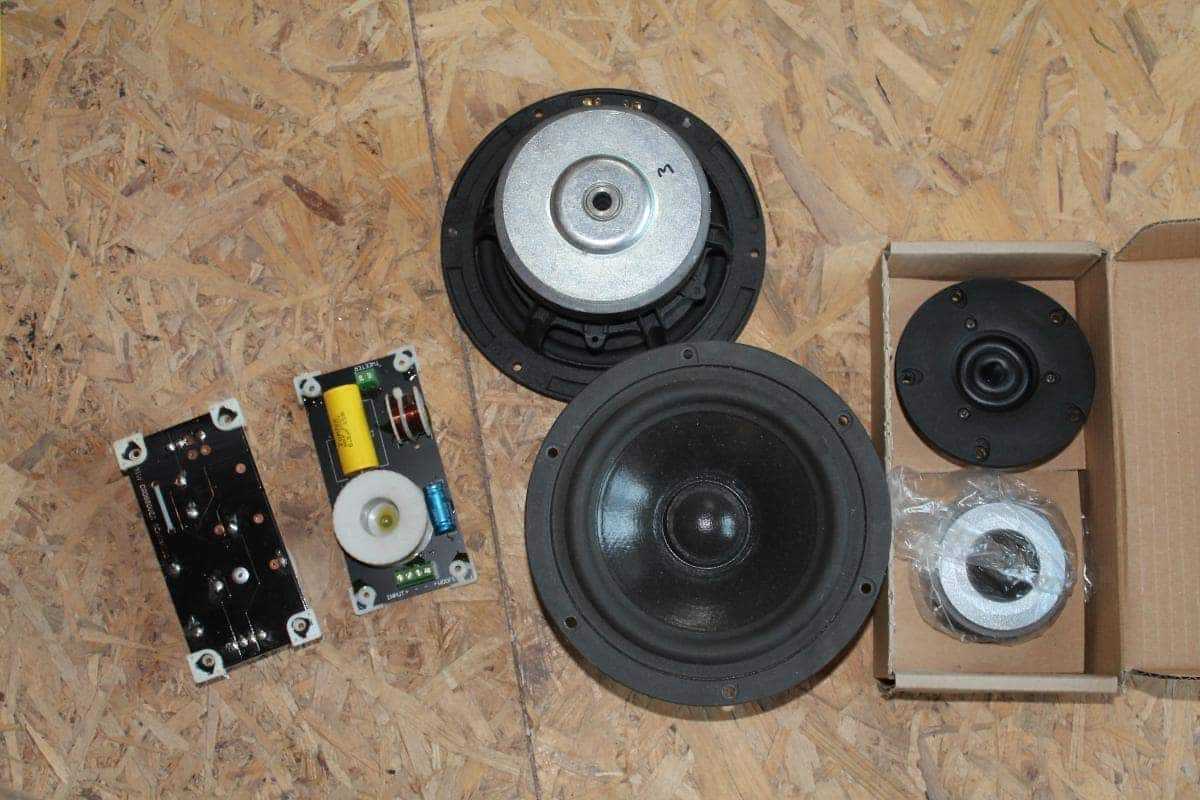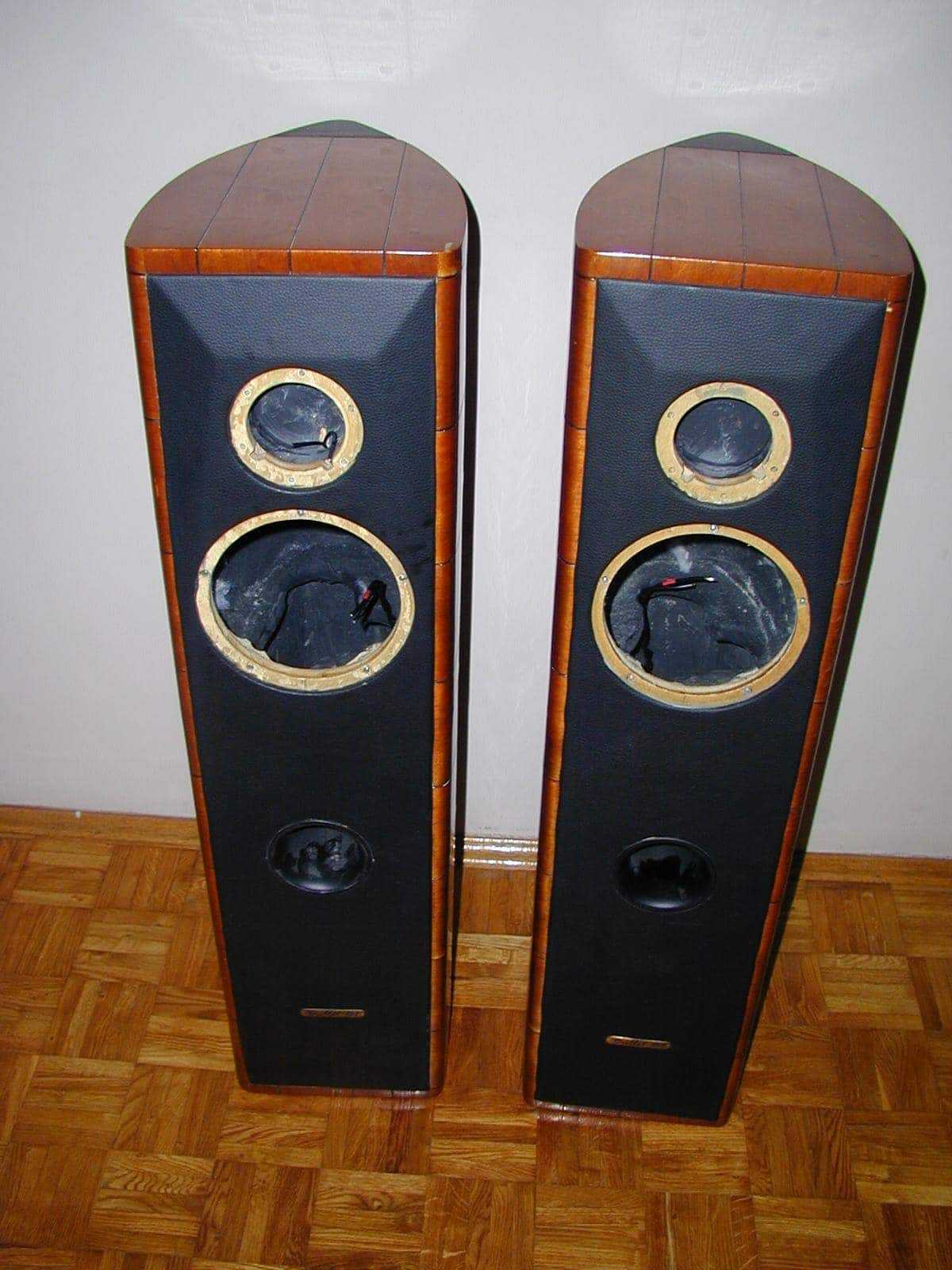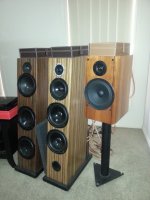Hello folks,
I am new in this game, so I would have to start from scratch
I can fairly cheaply get my hands on these drivers
Vifa PL18WO09-04
http://narbi.free.fr/manuels/HP - SUB/Vifa - Peerless V-line/PL18WO09-04.pdf
Vifa XT25TG30-04
http://www.parts-express.com/pedocs/specs/264-1016-vifa-xt25tg30-04-specifications-46530.pdf
That should be a good combo, the only problem is, I wanted to build a tall floor stander, possibly a slopped one with side firing woofers.
Could you please tell me if there is any chance that this mid-woofer could be used in such a scheme?
I could also, potentially, build a separate boxes for mid/tweeters and woofers if desirable.
Any info would be highly appreciated!
I am new in this game, so I would have to start from scratch
I can fairly cheaply get my hands on these drivers
Vifa PL18WO09-04
http://narbi.free.fr/manuels/HP - SUB/Vifa - Peerless V-line/PL18WO09-04.pdf
Vifa XT25TG30-04
http://www.parts-express.com/pedocs/specs/264-1016-vifa-xt25tg30-04-specifications-46530.pdf
That should be a good combo, the only problem is, I wanted to build a tall floor stander, possibly a slopped one with side firing woofers.
Could you please tell me if there is any chance that this mid-woofer could be used in such a scheme?
I could also, potentially, build a separate boxes for mid/tweeters and woofers if desirable.
Any info would be highly appreciated!
That is not the way to start. If you are new I suggest:
*Build a kit or well established design so you can follow along with measurements and design procedures. This hobby is all about measuring.
*A sealed system is a great way to start as they are a bit more tolerant to the box design.
*Your driver selection is a very good combo. Build the first ones as a small 2-way monitor. You can always tear it apart and build a bigger system later. (or set them on top of woofers like the Peerles XXLS)
*A three way is more than twice as hard as a two way. Don't set yourself up to fail.
Start slow. We all want to build the worlds greatest speaker in one shot. Guess what? After 35 years, I can build a darn good two-way and I see no end to what I can learn with them. Every build I set out something new to learn. Usually one electrical and one cabinet-making. I will be old and deaf before I master it. Most builds have two or three prototype cabinets before I build the nice one.
Please, speaker design is a multi-discipline engineering task. It is not screwing some drivers into a box. It takes work. A lot of work. The results can be amazing.
We don't know how much you have learned already. Do you have an electronics background? Do you understand T/S parameters? Do you know what BSC is? I am not trying to be flippant, but it does matter if we are going to point you in the right direction.
Read the papers on True Audio. At least browse Linkwitz. Learn about box modeling software like WinIds and Edge. At least read the manuals for measuring tools like HOLM, ARTA, LIMP, TrueRTA, and others to get an idea of the process.
*Build a kit or well established design so you can follow along with measurements and design procedures. This hobby is all about measuring.
*A sealed system is a great way to start as they are a bit more tolerant to the box design.
*Your driver selection is a very good combo. Build the first ones as a small 2-way monitor. You can always tear it apart and build a bigger system later. (or set them on top of woofers like the Peerles XXLS)
*A three way is more than twice as hard as a two way. Don't set yourself up to fail.
Start slow. We all want to build the worlds greatest speaker in one shot. Guess what? After 35 years, I can build a darn good two-way and I see no end to what I can learn with them. Every build I set out something new to learn. Usually one electrical and one cabinet-making. I will be old and deaf before I master it. Most builds have two or three prototype cabinets before I build the nice one.
Please, speaker design is a multi-discipline engineering task. It is not screwing some drivers into a box. It takes work. A lot of work. The results can be amazing.
We don't know how much you have learned already. Do you have an electronics background? Do you understand T/S parameters? Do you know what BSC is? I am not trying to be flippant, but it does matter if we are going to point you in the right direction.
Read the papers on True Audio. At least browse Linkwitz. Learn about box modeling software like WinIds and Edge. At least read the manuals for measuring tools like HOLM, ARTA, LIMP, TrueRTA, and others to get an idea of the process.
Hi,
Its all very doable with the right modelling if
you can trust the manufacturers graphs.
But you need to know what you are doing.
You could do a lot worse than :
https://sites.google.com/site/undefinition/tarkus
rgds, sreten.
http://audio.claub.net/Simple Loudspeaker Design ver2.pdf
FRD Consortium tools guide
Designing Crossovers with Software Only
Its all very doable with the right modelling if
you can trust the manufacturers graphs.
But you need to know what you are doing.
You could do a lot worse than :
https://sites.google.com/site/undefinition/tarkus
rgds, sreten.
http://audio.claub.net/Simple Loudspeaker Design ver2.pdf
FRD Consortium tools guide
Designing Crossovers with Software Only
Last edited:
Would you consider a powered subwoofer as the bass unit? That would be the easiest way and looking at the factory graph I'd say crossing to a sub at 200 is doable depending of course on the amplifiers electronics. Otherwise if you want deeper bass consider a .5 woofer as it is "usually" a little easier to implement than a true 3-Way speaker although not necessarily cheaper. I have no personal experience with those drivers but I understand they have been used in many successful designs
That is not the way to start. If you are new I suggest:
*Build a kit or well established design so you can follow along with measurements and design procedures. This hobby is all about measuring.
*A sealed system is a great way to start as they are a bit more tolerant to the box design.
*Your driver selection is a very good combo. Build the first ones as a small 2-way monitor. You can always tear it apart and build a bigger system later. (or set them on top of woofers like the Peerles XXLS)
*A three way is more than twice as hard as a two way. Don't set yourself up to fail.
Start slow. We all want to build the worlds greatest speaker in one shot. Guess what? After 35 years, I can build a darn good two-way and I see no end to what I can learn with them. Every build I set out something new to learn. Usually one electrical and one cabinet-making. I will be old and deaf before I master it. Most builds have two or three prototype cabinets before I build the nice one.
Please, speaker design is a multi-discipline engineering task. It is not screwing some drivers into a box. It takes work. A lot of work. The results can be amazing.
We don't know how much you have learned already. Do you have an electronics background? Do you understand T/S parameters? Do you know what BSC is? I am not trying to be flippant, but it does matter if we are going to point you in the right direction.
Read the papers on True Audio. At least browse Linkwitz. Learn about box modeling software like WinIds and Edge. At least read the manuals for measuring tools like HOLM, ARTA, LIMP, TrueRTA, and others to get an idea of the process.
Well, you're right, I should have definitely give some more info about meself
I am a professional opera singer, with some background in electronic engineering, do know the basics of speaker design, but really only the basics.
I recently moved to a bigger apartment, the listening room is some 25m2 big, and my B&W 601 S3 sound simply too small, the sound is so-so directly on axis, when I move 1m sideways, the sound is cut in half
I am pretty sure that small 2-way speaker is not going to satisfy my needs of having authoritative sound of symphony orchestra here.
I live in Serbia, the standard here is pretty low, so buying the set of hi-end loudspeakers is not an option, otherwise I would just buy B&W 801 and that would be it (or any of the higher range PMCs, as you can see, I like having a lot of bass in my system
So DIY is not a must for me, but I do have a lot of spare time, and could also do my homework on all the aspects of speaker building, and that seems like bigger fun
So, my idea here was, If you guys tell me that this set, which I can buy dirt cheap, could be a good start, I can just buy it and let it wait till I'm (hopefully with your help) ready to play with it

Would you consider a powered subwoofer as the bass unit? That would be the easiest way and looking at the factory graph I'd say crossing to a sub at 200 is doable depending of course on the amplifiers electronics. Otherwise if you want deeper bass consider a .5 woofer as it is "usually" a little easier to implement than a true 3-Way speaker although not necessarily cheaper. I have no personal experience with those drivers but I understand they have been used in many successful designs
I've never heard a REALLY good sub, so can't tell....
The ones I heard were never even close to a good 3-way design for the music I mainly listen to (mainly classical orchestra and opera recordings).
The best sounding DIY speaker I heard was this project with AUDAX drivers (the biggest speaker), that's why I like the idea of that implementation:
An externally hosted image should be here but it was not working when we last tested it.
There is another way to do this [ which I use as I'm not the best XO designer] and that is the use of electronic crossovers, this can range from cheap to very expensive and is easiest with a preamplifier and seperate power amplifiers.
Side firing woofers have an dedicated following and probably best used in pairs back to back on either side of the box
A Tarkus clone would probably also give what you want, I can't comment on the prebuilt XO; is it designed for those drivers and are there plans for the box that should be used
Side firing woofers have an dedicated following and probably best used in pairs back to back on either side of the box
A Tarkus clone would probably also give what you want, I can't comment on the prebuilt XO; is it designed for those drivers and are there plans for the box that should be used
how about this: Vifa PL18WO-,
with the Tarkus woofer as a .5 way on the bottom....?
with the Tarkus woofer as a .5 way on the bottom....?
how about this: Vifa PL18WO-,
with the Tarkus woofer as a .5 way on the bottom....?
In that case I should find one more pair of Vifa PL18WO-09-04 woofers for the rolled off pair, and I am afraid that is a mission impossible task
re:"the rolled off pair" - if you mean you need the same driver as the mids for a .5 way, that's not correct
I thought this was a must in a 2.5 way system

hi guys, that is a great driver as I have had it in my DIY ref speaker since 2006 and have tweeked the hell out of mine.
I implemented a 2.5 with 4 drivers. the 2 audax 8 inch are the .5 rolling off at 200hz and the vifa goes all the way to 1.8khz crossover to a satori tweeter. I originally had the xt25 in there but once I swapped it out for the satori I fell in love with it.
this speaker uses a series crossover and the 2 drivers are in their own section of the cabinet.
you have a beautiful cabinet already just add an 8 inch peerless to the bottom of the cabinet and this could make a lovely speaker.
I implemented a 2.5 with 4 drivers. the 2 audax 8 inch are the .5 rolling off at 200hz and the vifa goes all the way to 1.8khz crossover to a satori tweeter. I originally had the xt25 in there but once I swapped it out for the satori I fell in love with it.
this speaker uses a series crossover and the 2 drivers are in their own section of the cabinet.
you have a beautiful cabinet already just add an 8 inch peerless to the bottom of the cabinet and this could make a lovely speaker.
Attachments
Again, you have a good basis, but this is a very ambitious project. To design a speaker takes me about 6 months for a "simple" two way. The driver set is very good, but....
As much as I love building speakers, if you have a set of small B&W's, PROPER subs are as integrated and musical as any full range floor standers. A set of Peerless 12's in sealed 60 Liter boxes used as bases under your B&W's would give a set of 801's a run for the money. I prefer a real 24dB active crossover to a high quality amp. Many subs are destroyed by the assumption the AVR sub out is all you need. I run "full" out of the AVR or preamp and then to a real active crossovers. I will sometimes throw an eq in the sub line, but in most rooms, a low Q sealed sub matches the room gain pretty well and you don;t need much. The really nifty advantage of subs as main stads is you can raise the crossover frequency for best eq. You are not forced to be in the 60 or so range just to have no localization, but can go 200 or 300 is the sub is good enough. This can do wonders for mid-range distortion. Don't call them add on subs, call them true woofers.
To get the imaging you are looking for, room treatments are a must. Big panels on the front wall do wonders. DIY of course.
With your background, you may be able to measure by ear, but tools make it far easier. We spent weeks in the old days arguing what was wrong with prototypes where today we can measure and get the hint in minutes. Final voicing is always still by ear.
Go to Linkwitz and see how to build a mic for almost nothing. All it takes is a PC after that. So not measuring has no excuse.
As much as I love building speakers, if you have a set of small B&W's, PROPER subs are as integrated and musical as any full range floor standers. A set of Peerless 12's in sealed 60 Liter boxes used as bases under your B&W's would give a set of 801's a run for the money. I prefer a real 24dB active crossover to a high quality amp. Many subs are destroyed by the assumption the AVR sub out is all you need. I run "full" out of the AVR or preamp and then to a real active crossovers. I will sometimes throw an eq in the sub line, but in most rooms, a low Q sealed sub matches the room gain pretty well and you don;t need much. The really nifty advantage of subs as main stads is you can raise the crossover frequency for best eq. You are not forced to be in the 60 or so range just to have no localization, but can go 200 or 300 is the sub is good enough. This can do wonders for mid-range distortion. Don't call them add on subs, call them true woofers.
To get the imaging you are looking for, room treatments are a must. Big panels on the front wall do wonders. DIY of course.
With your background, you may be able to measure by ear, but tools make it far easier. We spent weeks in the old days arguing what was wrong with prototypes where today we can measure and get the hint in minutes. Final voicing is always still by ear.
Go to Linkwitz and see how to build a mic for almost nothing. All it takes is a PC after that. So not measuring has no excuse.
- Status
- This old topic is closed. If you want to reopen this topic, contact a moderator using the "Report Post" button.
- Home
- Loudspeakers
- Multi-Way
- Help needed: Vifa drivers in a 3-way speaker

